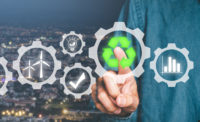What is the best way to achieve environmental sustainability? It isn’t simply to recycle or to use recycled products, according to a survey of attendees at the recent Greenbuild Conference and Expo. Instead, respondents favored a more comprehensive approach to the environment that includes reducing overall consumption of both products and resources.
The survey, conducted by Kimberly-Clark Professional in November 2009, asked 169 Greenbuild attendees what their organizations were doing to be more environmentally responsible. Three-quarters selected “reducing consumption of resources-such as water and energy” from a list of choices. In response to a similar question about which building practices would be most beneficial to the environment, 63% picked “finding more ways to reduce overall consumption.” Only 25% chose “increasing recycling or the use of recycled materials.”
“The survey results underscore the importance of taking a bigger-picture approach to environmental sustainability,” said Lisa Morden, global sustainability leader for Kimberly-Clark Professional. “It’s good to think about recycling, but it’s time to think about reducing.”
The survey also polled attendees about a broad range of other topics related to sustainability. Among the findings:
- 78% believed that trees were a renewable resource that can be used responsibly for the production of towel, tissue and other paper products.
- Two-thirds of respondents expect to pay a little more when purchasing environmentally responsible products. (31% expect to pay the same amount.)
- 64% said they had either achieved green building certification or were in the processing of applying for it. 21% said they had not done so but were considering it.
When asked about their organizations’ future environmental concerns, 32% of respondents said they expected to be most focused on water availability and water quality. This was followed by climate change (26%), landfill availability or waste disposal concerns (23%), and air quality/pollution (14%).
Greenbuild attendees were also asked to select the statement that best described the importance of environmentally responsible products for commercial facilities today as compared to a few years ago. The top choice (according to 41% of respondents) was: “Environmental responsibility is a crucial component of all purchasing decisions today.” A close second, at 36%, was: “Buying environmentally responsible products is becoming more important each year.” Twenty-two percent said environmentally responsible products were important, but “can’t break the bank. It has to be balanced against costs.”
The survey was conducted at the Greenbuild International Conference and Expo in Phoenix, Ariz., on November 11, 2009. The survey questionnaires were filled out by 169 professionals responsible for the specification or purchase of products for commercial or institutional properties, such as office buildings, schools, hospitals or other facilities. Respondents described themselves as being from the following job categories: building owner/manager, purchasing, interior design, maintenance/engineering, architect and construction.
For more information, visitwww.kcprofessional.com.


